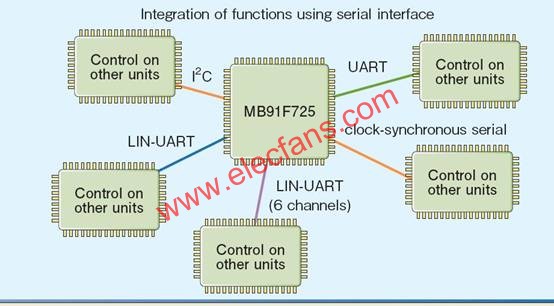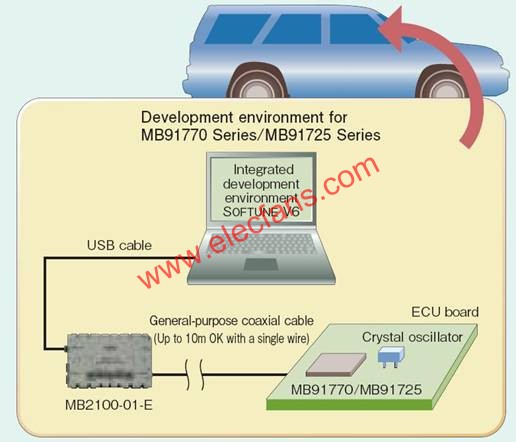Today's automobiles have entered the era of intelligent and environmentally friendly design. In terms of intelligence, digital electronic technology is used to improve the safety and comfort of automobiles. In terms of environmental protection, fuel economy, electric hybrid vehicles, and electric vehicles are used to achieve energy saving The goal of carbon. Therefore, today's cars are becoming more and more electronic. From infotainment, body, safety to power transmission systems, the use of electronic components for sensing and control has penetrated into every corner of the car. In various systems of automotive electronics, microcontrollers (MCUs) are often used as the core of operational control, and the reliance of automobiles on electronic systems also stimulates the rapid growth of the automotive microcontroller market. Microcontrollers for cars cover 8-, 16-, and 32-bit low-, medium-, and high-end product grades, each with its own suitable application system, roughly as follows: 8-bit MCU: mainly used in various sub-systems of the car body, including fan control, air conditioning control, wipers, sunroof, window lift, low-end instrument panel, hub box, seat control, door control module, etc. control function. 16-bit MCU: Main applications are power transmission systems such as engine control, gear and clutch control, and electronic turbine systems; also suitable for chassis mechanisms such as suspension systems, electronic power steering wheels, torque dispersion control, and Electronic pumps, electronic brakes, etc. 32-bit MCU: main applications include dashboard control, body control, multimedia information system (TelemaTIcs), engine control, and emerging intelligent and real-time safety systems and power systems, such as pre-crash, adaptive Safety functions such as cruise control (ACC), driver assistance systems, electronic stability programs, and complex X-by-wire transmission functions. Common interface of MCU for car: CAN & LIN As today's automotive requirements for application functions are getting higher and higher, the systems to be integrated are becoming more and more complex, making the demand for high-end 32-bit MCUs in automotive electronic systems increasing. Such vehicle MCUs are often placed in an operating environment with high heat, dust, shocks, and severe electronic interference, so the requirements for tolerance are much higher than general-purpose MCUs. In addition, in the automotive application environment, the automotive MCU must be connected to multiple automotive electronic control devices (ECUs), among which the most common transmission interfaces are CAN and LIN. CAN is divided into high-speed CAN and low-speed CAN. The transmission rate of high-speed CAN can reach 1 Mbps, which is suitable for applications that emphasize real-time response such as ABS and EMS; low-speed CAN can reach 125 Kbps, which is suitable for lower-speed car body parts control. In addition, the types of CAN controllers can be divided into the old 1.x, the standard 2.0A and the extended 2.0B. The newer the specifications, the better the performance. The 2.0B can be divided into passive and passive Active (acTIve) type. LIN is a lower speed and lower cost communication solution than CAN. It adopts the concept of a master node and multiple slave nodes (supports up to 16 nodes), up to 20 kbps data transmission rate, and the length of the bus cable can be expanded to 40 meters. It is very suitable as climate control, mirrors, door modules, seats, smart switches, and low-cost sensors. Distributed communication solutions for simpler systems. The following will introduce a new generation of MCU technology applied to dashboard control and body control, and take Fujitsu's new generation of MB91770 series and MB91725 series of new microcontrollers as design references. Please refer to (Figure 1). Figure 1 The application of instrument panel control and body control MCU in automobiles (taking MB91770 series and MB91725 series as examples) The main points of car dashboard and body control design The dashboard of the car provides a variety of real-time visual information for the driver. This information is an important reference for assisting decision-making and must be quickly and accurately communicated to the driver. In addition, the air conditioning and body control module (BCM) system in the car is responsible for providing a comfortable ride environment for drivers and passengers. Among them, the optimal control of the air conditioning system quickly reduces the temperature inside the car to a more comfortable level, and maintains a comfortable interior temperature based on the information from various sensors. The BCM system can centrally control multiple ECUs, such as doors, seats, and combination switches. Whether it is a dashboard control or body control MCU, it must provide higher processing performance, the ability to handle a large number of network nodes, interface functions that support multiple peripheral connections, functions that can expand the scope of circuit board layout, advanced memory architecture, And a more convenient development environment. The analysis of these design requirements is as follows: High processing performance: To improve processing performance, MCU must start from its core and software and hardware system architecture. Take Fujitsu's new generation MCU FR81S CPU core as an example. Its working performance reaches 1.3MIPS / MHz, which is 30% higher than the previous generation FR60 core. Efficiency; due to the built-in single-precision floating-point arithmetic unit (FPU), it can meet the requirements of image processing systems and those systems that require floating-point operation functions (such as brake control). In addition, through hardware-based FPU support, it can simplify software programs and improve computing performance. 2. Processing capacity of a large number of network nodes: There are a large number of built-in ECUs in the CAN network in today's cars. Their scale continues to expand with the increase in the number of nodes. Therefore, MCUs for vehicles must support more message buffers. The previous generation of 32-bit CAN microcontrollers can provide up to 32 built-in message buffers, but now it is not enough to use. For the new generation of Fujitsu MCU, it can already support up to 64 built-in message buffers, and support CAN 2.0A / B specification and provides high transmission rate of 1Mbps. 3. Extensive interface support capabilities: The peripherals connected to the automotive MCU are quite diverse, and the connected interfaces may be UART, frequency synchronous serial, LIN-UART and I2C, so it must have flexible interface connection capabilities. In order to meet this demand, Fujitsu uses the built-in multifunctional serial interface as a serial communication interface, and switches the above-mentioned various interfaces through software to flexibly support the communication specifications of external components and increase the freedom of system design. The new series of MCUs also provide 6 channels of LIN-UART, so that they can communicate with more control units; among them, MB91725 series is easier to achieve the integration of various functions due to the multiple channels with timer function and A / D converter . Please refer to (Figure 2). Figure 2: Using serial interface to achieve flexible communication interface function integration Functions that can expand the layout of the circuit board: Because the layout design of the circuit board system for vehicles is quite diverse, the MCU for vehicles must be able to meet the needs of these designs. Some feasible measures include configuring an independent power supply for the external bus interface terminal, so that there is no need to install a level shifter on the ECU board. The power supply range of this external bus interface terminal should be wide (such as covering 3.0V to 5.5V), and then it can be flexibly connected to the unit memory or image with ASIC. Another method is to let the MCU have the built-in I / O redistribution function, and the allocation of I / O ports can be changed through software settings. In this way, designers can connect with specific peripherals more flexibly, thereby greatly improving the freedom of circuit board layout. 5. Advanced memory architecture: In order to improve the flexibility of work processing, embedded memory (Flash) is often built into today's automotive microcontroller systems. In the past, only Flash was used for program storage, and Flash for data was added to the architecture of the new generation MCU. This architecture not only improves the data writing speed, but also reduces the area of ​​the circuit board because it no longer requires E2PROM. In addition, storing data and programs in the Flash memory of the microcontroller at the same time also helps prevent information leakage. 6. More convenient development environment: General products must use the ICE main unit and verification evaluation chip for system verification. In order to reduce the complexity of verification, we provide on-chip error detection for the new generation of MCU products. It uses a single-wire debugging interface, which can achieve automotive evaluation or conformance testing, and can use a common coaxial cable to achieve communication between the small ICE main unit and the target circuit board within a range of up to 10 meters. This can simplify car evaluation that is conventionally difficult to achieve. Figure 3: Using on-chip error detection to realize car evaluation in conclusion The electronic system in a car is getting more and more complicated, and the dependence on the MCU for cars is getting deeper and deeper. For the design of car dashboard and body control, accurate and rapid auxiliary information must be provided for driving, as well as convenient and comfortable riding space. Therefore, related MCUs must also meet higher performance and more flexible design requirements before they can be used for application functions. Development brings help.
Decorative Outdoor Curtain Led Display Screen is the perfect architectural decoration patterns in the daytime and night. And it becomes LED Display screen to display image and video at night.It is ultra light weight design, which is easy to install. The convenient installation help everyone can install it easily by oneself. It can be packaged in one CMB which is save a lot in transportation. It is not only good for transport but also good for maintenance. Front and back maintain are available due to its special design.LED curtain mesh screen can be installed directly on the wall or glass. The hollow design makes permeability up to 70% which is conducive to ventilation and lighting. The exquisite appearance is good for decoration of shopping mall, hotel, office building and 5s shop etc.The frame shell save install material can be fixed easily. High-intensity sealed lamp with high quality up to IP67 protection level. The beautiful patterns can be customized for customer.LED curtain mesh screen can display text, image and video. Low power consumption is also good for long life span.IP67 protection rate features waterproof, anti-dust, wind resistant and anti-corrosion which is suitable for all kinds of using environment.LED curtain mesh screen is very easy to set up. The cabinet was designed by our engineer very attentively and adopted advanced technology to manufacture which support front and rear installation. Cooling with wind is environment friendly and make noise free.Led Curtain Screen is widely used in stadium, shopping mall, 5s car shop and theme park etc.
Outdoor Curtain Led Display,Curtain Led Screen,Led Curtain Screen,Outdoor Led Curtain Shenzhen Bako Vision Technology Co., Ltd. , http://www.rentalleddisplays.com


